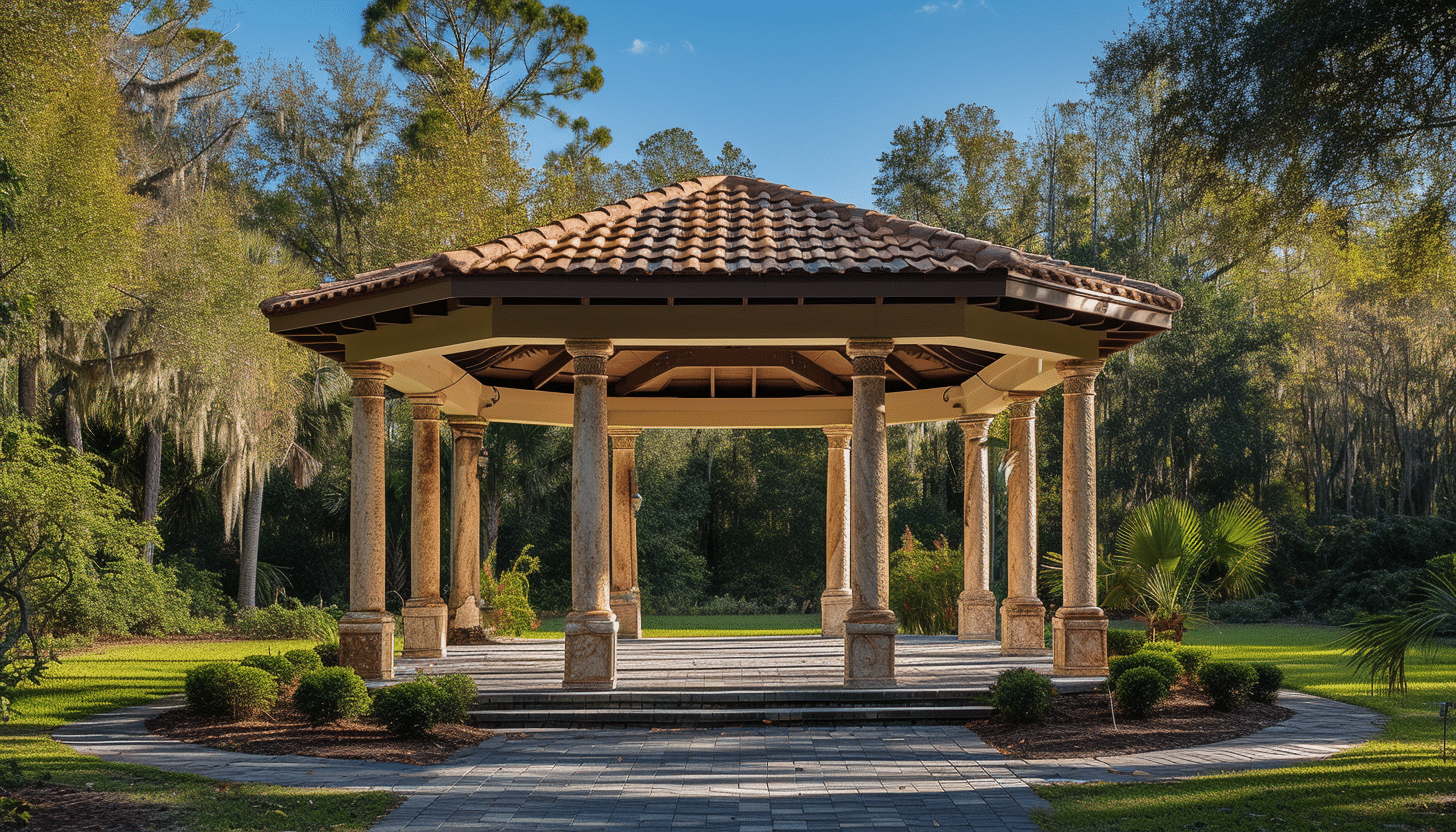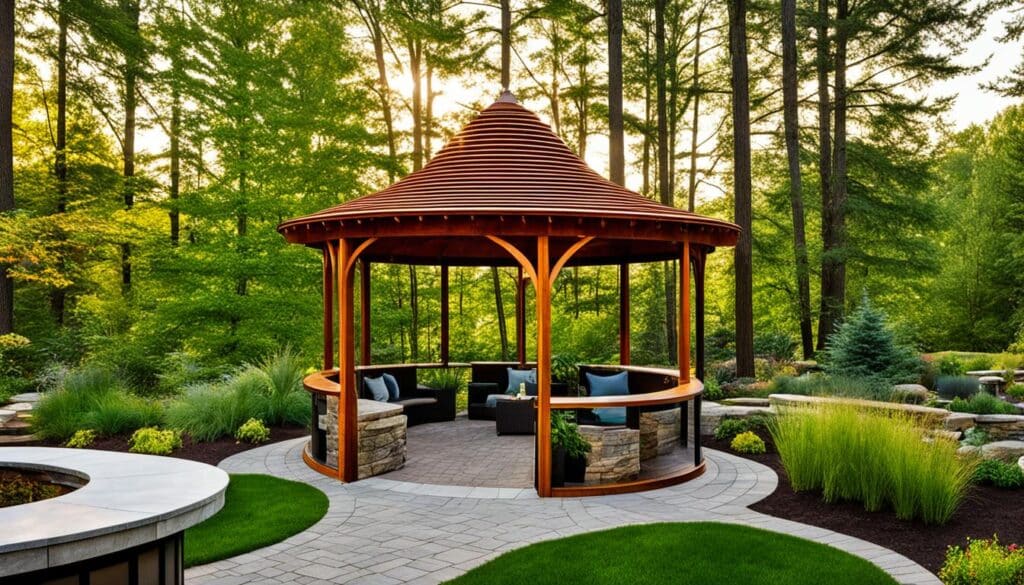A pavilion is an elegant and versatile outdoor structure with historical roots in Eastern American colonies. Often found in 18th and 19th-century gardens, pavilions range from tent-like forms to architectural extensions and summerhouses. Historically, social spaces now predominantly serve as permanent features that harmoniously blend architecture with nature.

Key Takeaways
- A pavilion is a versatile architectural feature with multiple interpretations.
- Pavilions have a rich history dating back to 18th and 19th-century America, particularly in the Eastern colonies.
- While providing shelter, pavilions skillfully integrate with their surrounding environment, often becoming a central outdoor structure within a landscape.
- Pavilions can be temporary or permanent structures, and some can even serve as garden canopies for specific occasions.
- The definition of a pavilion incorporates a blend of practicality and aesthetics, making it an ideal solution for harmonizing constructed and natural environments.
The Historical Evolution of Pavilions
Embarking on our exploration of the captivating journey pavilions have traversed, we discover how deeply this architectural feature has influenced landscape design and how it is imbued into our cultural heritage. Pavilions have functioned as garden canopies, park aesthetic enhancers, and outdoor event spaces. They have served us generously, offering arts, entertainment, and reprieve. Let’s delve into their history.

The Origins and Adaptations of Pavilions in Landscape Design
The saga of pavilions begins as an architectural expression blending Eastern and European influences. Pavilion architecture found roots in European fascination with the exotic culture of the East. Over time, these design concepts were adapted across an array of landscapes. From James Gibbs’s “Eight Square Pavilions” to Alexander Jackson Davis’s pavilion at Blithewood, the pavilion evolved, each design adaptation further enriching its definition.
Pavilions from Eastern Colonies to Modern America
Anchored in American heritage, pavilions have traveled across centuries, from the Eastern colonies to today’s modern landscapes. Ephraim Chambers and Samuel Johnson depicted pavilions as versatile structures—as tent-like shelters, projecting features of a building, or separate garden structures. These definitions illuminate the versatility at the heart of a pavilion’s design, encapsulating the quintessential characteristics that make them such an integral part of American landscape architecture.

“A Pavilion is an open air room” – Downing
Thomas Jefferson’s Contribution to Pavilion Architecture
One cannot discuss the history of pavilions without acknowledging Thomas Jefferson’s seminal influence on pavilion architecture. Famed for his classically ordered structures bedecked in gardens and connected by covered walkways, Jefferson’s pavilions gracefully integrated architecture and landscapes. As professors’ residences and libraries at the University of Virginia and Monticello, these structures are a testament to the harmonious blend between function and aesthetic in pavilion design, truly a milestone in the historical narrative of pavilions.
Defining a Pavilion: The Various Interpretations
As we delve into the realm of pavilions, it becomes clear that these captivating architectural features embody a rich mélange of interpretations. From being a mere temporary shelter to an elaborate garden canopy, a pavilion’s definition extends far and wide. However, amidst this diversity, certain distinctive traits remain consistent.
Common Features of Pavilions Through Time
Regardless of their various interpretations, pavilions are universally identified by their single-roof structure. This distinctive architectural feature makes them an ideal shelter, often enveloping a garden seat or recreational area. Over time, this outdoor structure has married functionality with aesthetic allure, showcasing an array of designs; some exude rustic charm with climbing plants’ embellishments, while others evoke a sense of grandeur with their classical-style circular temples. This diversity stems from a pavilion’s inherent adaptability, allowing it to blend seamlessly with surrounding architectural and topographical elements.

The Versatility of Pavilions in Function and Design
Another remarkable facet that enriches the pavilion’s definition is its versatility in function and design. A pavilion, like an open-air enclosure, looking nothing more than a humble shelter, may serve a multitude of purposes. Rooted in various spots within a landscape, pavilions present themselves as sanctuaries of rest and contemplation, offering breathtaking vantage points. Whether it serves as a modest ‘pavilionrustique’ or a grand garden temple, the underlining purpose of a pavilion is always to proffer a refreshing open-air respite beneath a protective canopy, contributing greatly to the visual harmony of the natural environs.
Table showcasing the various roles of pavilions:
| Design Type | Primary Function | Architectural Aesthetics |
|---|---|---|
| Garden Seat Pavilion | Rest and Contemplation | Rustic and draped with climbing plants |
| Circular Temple Pavilion | Visual Focal Point | Classical-style architecture |
| Pavilionrustique | Shelter and Contemplation | Naturalistic, modest design |
| Garden Temple | Social and Recreational Center | Grand and elaborate architectural form |
The value of a pavilion transcends its physical construct; it is the essence of enhancing the communal and aesthetic experience of an outdoor space.
Differentiating Between Outdoor Structures

In enjoying the essence of the great outdoors right in our residential spaces, the incorporation of various outdoor structures can greatly augment the overall experience. Each outdoor setting requires unique elements, be it for recreational, aesthetic, or functional purposes. The wide variety of structures available, such as pavilions, pergolas, arbors, and cabanas, offers plausible choices for us to enhance the beauty and functionality of our outdoor living spaces.
Understanding the Purposes of Arbors, Pergolas, Cabanas, and Pavilions
Each outdoor structure, from arbors and pergolas to cabanas and pavilions, offers its unique charm and purpose. Arbors are small gateways that add subtle elegance, while pergolas provide shaded areas to enhance landscapes. Cabanas, associated with pools, offer a luxurious, resort-like feel with amenities for relaxation. Pavilions are versatile, ideal for large gatherings, and have the capacity to accommodate outdoor kitchens and seating, making them perfect for events and family functions.

Choosing the Right Structure for Your Backyard: From Aesthetics to Functionality
Choosing the right structure for your outdoor space depends on its use and your backyard’s size. Smaller yards benefit from elegant arbors that enhance aesthetics without taking up much space. Larger yards suit pergolas, providing shade and visual appeal, especially when adorned with plants. Cabanas are perfect for poolside convenience, offering shade and privacy. To foster social interactions, pavilions in big backyards provide shelter for gatherings. Ultimately, the choice should reflect your personality and lifestyle, significantly improving your yard’s look and functionality.
Conclusion
Pavilions, spanning various designs and purposes, have evolved with humanity’s outdoor engagement, blending architecture with nature. These structures, ranging from simple shelters to ornate spaces for socializing, underscore the aesthetic and functional harmony between human-made environments and the natural world. They offer unique recreational spots that enhance outdoor experiences, reflecting our desire to enrich our communal spaces. Ultimately, pavilions represent more than architecture; they symbolize our ongoing quest to integrate built environments with the natural landscape, enriching our outdoor experiences and contributing to our sense of place and community in the great outdoors.
FAQs
What is a pavilion?
A pavilion is an architectural feature, often an outdoor structure. It may be described as a single-roof structure, usually open on all sides. It is often used as a temporary shelter, event space, or garden canopy.
How has the use of pavilions evolved over time?
Pavilions have been adapted for various functions, from being a manifestation of European fascination with Eastern culture in the colonial era to a structural articulation within the sweeping views of institutional and private landscapes. They served both practical and aesthetic purposes, enriching the interplay between built and natural environments.
How did Thomas Jefferson contribute to pavilion architecture?
Jefferson’s pavilions were characterized by classical order, connected by covered walkways and flanked by gardens, underscoring the integration of architecture and landscape. These structures, initially serving as professor’s houses and libraries, are a testament to the connection between function and aesthetics in pavilion design.
What are the common features of pavilions over time?
A pavilion is typically identified by its single-roof structure, which provides shelter over a garden seat or a recreational area. Pavilions encompass a variety of designs, from rustic appearances with climbing plants to classical-style temples.
What roles do pavilions serve?
Pavilions epitomize versatility, serving a wide array of functions. These structures have been located in various locations within a landscape to serve as places of rest and contemplation, providing magnificent views. The primary purpose of pavilions remains to provide open-air respite beneath a protective canopy that visually corresponds with the natural surroundings.
How does a pavilion differ from other outdoor structures like arbors, pergolas, and cabanas?
Outdoor structures like arbors, pergolas, cabanas, and pavilions each possess distinct characteristics catering to various needs and aesthetics. Arbors, often the entranceway to gardens, are generally smaller, while pergolas, providing shade over patios or decks, can be more expansive. Cabanas are associated with poolside activities. In contrast, pavilions are the most versatile among them, potentially accommodating numerous guests for entertainment purposes or housing outdoor kitchens.
How do I choose the right outdoor structure for my backyard?
Selecting the appropriate outdoor structure for a backyard depends significantly on the intended use and spatial dynamics. An arbor suits smaller spaces seeking an aesthetic touch, while a pergola is ideal for larger backyards requiring a covered area. Cabanas complement poolside settings with their quick-function design, while pavilions cater to long backyards geared towards frequent entertainment.

I’m Elliot Bock, an expert at Total Site Amenities, specializing in transforming outdoor spaces. With a focus on aesthetic and functionality, I work closely with project managers and HOAs to tailor each project to their unique needs. My approach simplifies the complex, making me a trusted partner in crafting personalized outdoor solutions. My passion lies in enhancing community spaces, ensuring every project delivers both beauty and practicality.

